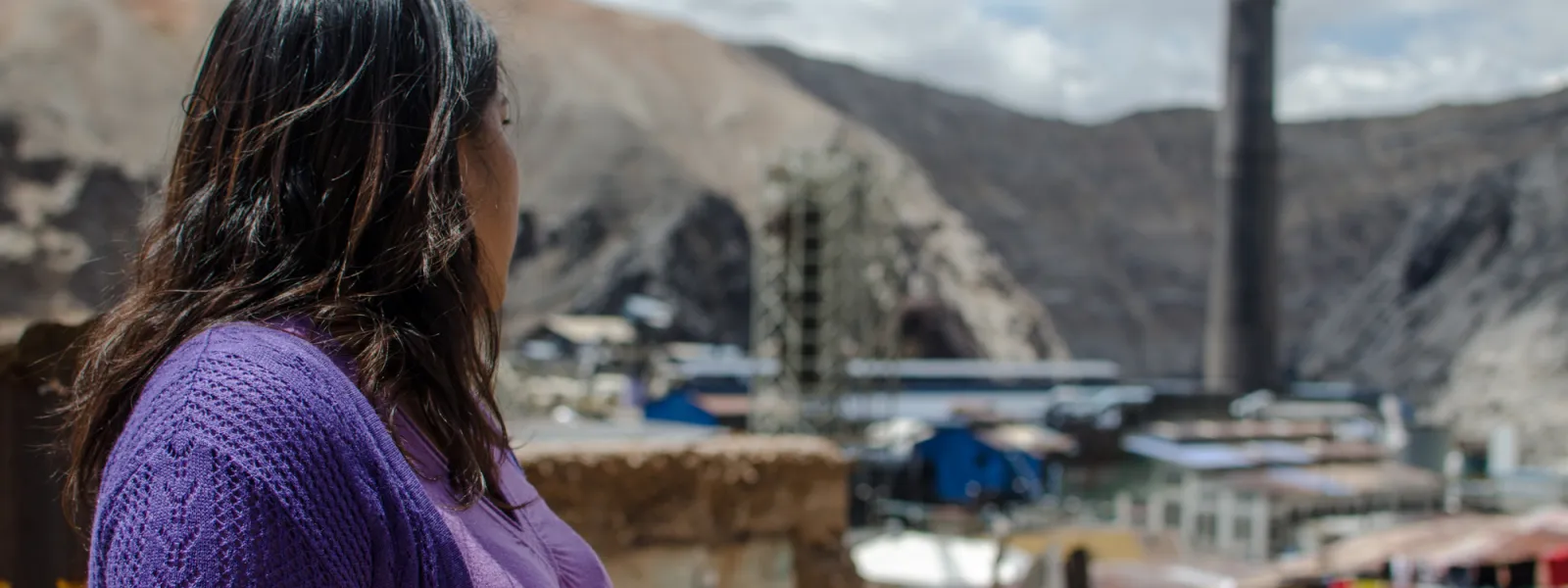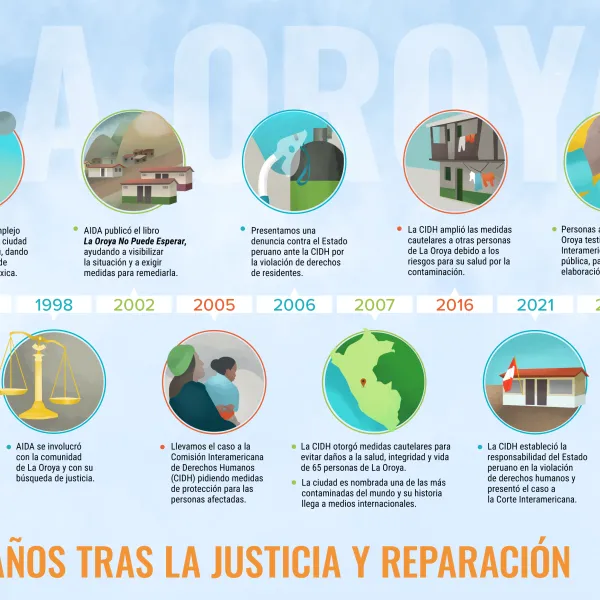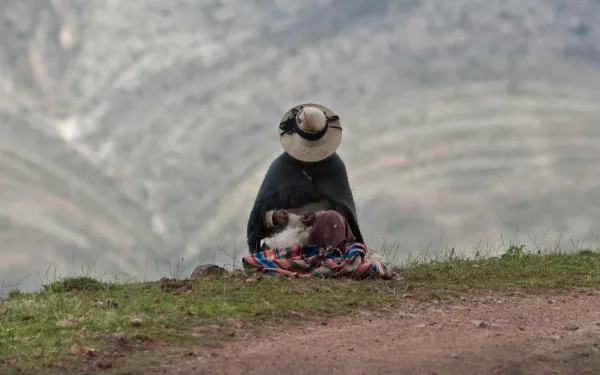
Project
Protecting the health of La Oroya's residents from toxic pollution
For more than 20 years, residents of La Oroya have been seeking justice and reparations after a metallurgical complex caused heavy metal pollution in their community—in violation of their fundamental rights—and the government failed to take adequate measures to protect them.
On March 22, 2024, the Inter-American Court of Human Rights issued its judgment in the case. It found Peru responsible and ordered it to adopt comprehensive reparation measures. This decision is a historic opportunity to restore the rights of the victims, as well as an important precedent for the protection of the right to a healthy environment in Latin America and for adequate state oversight of corporate activities.
Background
La Oroya is a small city in Peru’s central mountain range, in the department of Junín, about 176 km from Lima. It has a population of around 30,000 inhabitants.
There, in 1922, the U.S. company Cerro de Pasco Cooper Corporation installed the La Oroya Metallurgical Complex to process ore concentrates with high levels of lead, copper, zinc, silver and gold, as well as other contaminants such as sulfur, cadmium and arsenic.
The complex was nationalized in 1974 and operated by the State until 1997, when it was acquired by the US Doe Run Company through its subsidiary Doe Run Peru. In 2009, due to the company's financial crisis, the complex's operations were suspended.
Decades of damage to public health
The Peruvian State - due to the lack of adequate control systems, constant supervision, imposition of sanctions and adoption of immediate actions - has allowed the metallurgical complex to generate very high levels of contamination for decades that have seriously affected the health of residents of La Oroya for generations.
Those living in La Oroya have a higher risk or propensity to develop cancer due to historical exposure to heavy metals. While the health effects of toxic contamination are not immediately noticeable, they may be irreversible or become evident over the long term, affecting the population at various levels. Moreover, the impacts have been differentiated —and even more severe— among children, women and the elderly.
Most of the affected people presented lead levels higher than those recommended by the World Health Organization and, in some cases, higher levels of arsenic and cadmium; in addition to stress, anxiety, skin disorders, gastric problems, chronic headaches and respiratory or cardiac problems, among others.
The search for justice
Over time, several actions were brought at the national and international levels to obtain oversight of the metallurgical complex and its impacts, as well as to obtain redress for the violation of the rights of affected people.
AIDA became involved with La Oroya in 1997 and, since then, we’ve employed various strategies to protect public health, the environment and the rights of its inhabitants.
In 2002, our publication La Oroya Cannot Wait helped to make La Oroya's situation visible internationally and demand remedial measures.
That same year, a group of residents of La Oroya filed an enforcement action against the Ministry of Health and the General Directorate of Environmental Health to protect their rights and those of the rest of the population.
In 2006, they obtained a partially favorable decision from the Constitutional Court that ordered protective measures. However, after more than 14 years, no measures were taken to implement the ruling and the highest court did not take action to enforce it.
Given the lack of effective responses at the national level, AIDA —together with an international coalition of organizations— took the case to the Inter-American Commission on Human Rights (IACHR) and in November 2005 requested measures to protect the right to life, personal integrity and health of the people affected. In 2006, we filed a complaint with the IACHR against the Peruvian State for the violation of the human rights of La Oroya residents.
In 2007, in response to the petition, the IACHR granted protection measures to 65 people from La Oroya and in 2016 extended them to another 15.
Current Situation
To date, the protection measures granted by the IACHR are still in effect. Although the State has issued some decisions to somewhat control the company and the levels of contamination in the area, these have not been effective in protecting the rights of the population or in urgently implementing the necessary actions in La Oroya.
Although the levels of lead and other heavy metals in the blood have decreased since the suspension of operations at the complex, this does not imply that the effects of the contamination have disappeared because the metals remain in other parts of the body and their impacts can appear over the years. The State has not carried out a comprehensive diagnosis and follow-up of the people who were highly exposed to heavy metals at La Oroya. There is also a lack of an epidemiological and blood study on children to show the current state of contamination of the population and its comparison with the studies carried out between 1999 and 2005.
The case before the Inter-American Court
As for the international complaint, in October 2021 —15 years after the process began— the IACHR adopted a decision on the merits of the case and submitted it to the Inter-American Court of Human Rights, after establishing the international responsibility of the Peruvian State in the violation of human rights of residents of La Oroya.
The Court heard the case at a public hearing in October 2022. More than a year later, on March 22, 2024, the international court issued its judgment. In its ruling, the first of its kind, it held Peru responsible for violating the rights of the residents of La Oroya and ordered the government to adopt comprehensive reparation measures, including environmental remediation, reduction and mitigation of polluting emissions, air quality monitoring, free and specialized medical care, compensation, and a resettlement plan for the affected people.
Partners:

Related projects

Strategic litigation and its role in the pursuit of justice
In La Guajira, Colombia, indigenous Wayuu and Afro-Colombian communities—accompanied by civil society organizations—initiated litigation to defend their rights to water, food security and ethnic integrity, all of which are at risk from the diversion of the Bruno stream for the expansion of El Cerrejón, the largest open-pit coal mine in Latin America. The goal of bringing this particular case to court is not only to prevent the loss of an important water source. The litigation also seeks to set a precedent in the country and on the continent for the protection of rural communities against the systematic violation of their rights. It also represents an important action in the face of the climate crisis, a global problem aggravated by the continued extraction and burning of coal and other fossil fuels. The case can be categorized as strategic litigation, also called impact litigation, which consists of selecting and filing a lawsuit in order to promote the protection of rights or changes in public policy, while achieving broad changes in society, i.e., those that extend beyond a particular case. Strategic litigation is a tool that, through the law, promotes social transformations and strengthens human rights protections. It is strategic because, based on a legal cause, it seeks to change unjust realities and position issues that are key to the formation of a democratic society. In this sense, the ultimate goal of strategic litigation is to leave a lasting mark, a judicial precedent that can be replicated. It is also strategic because it includes the use of communication strategies, social mobilization, and political advocacy to put relevant debates on the table regarding the recognition of rights. When legal actions involve local communities, they also become a tool to help strengthen their internal processes of defense. Its premises and characteristics have made strategic litigation an important means to promote the protection of key ecosystems and human rights, including the right to health and a healthy environment, and the rights of indigenous peoples, communities and groups in vulnerable situations. Components As described above, strategic litigation is consciously designed to achieve broad goals and to generate a roadmap for future litigation. It consists of many different elements, including the following: A robust legal strategy that, on many occasions, must be enriched with interdisciplinary technical and scientific arguments. A communications strategy. Social or community organizing, which means involving communities, networks and local organizations in all phases of the litigation under a perspective of active participation and collective strategy construction. A strategy to protect against scenarios of risk that the litigation may cause. Political advocacy before decision-makers. Objectives and scope Although there are many, three main objectives of strategic litigation are to: Place important debates in the public opinion. Promote social mobilization around a common cause. Strengthen the rule of law, which means that citizens invite the State and judges to recognize rights, make problems visible, and ultimately strengthen the democratic system. Strategic litigation has been especially important for struggles and causes in which it is difficult for social movements and communities to position the recognition of their rights in legislative and public policy agendas. At AIDA, we believe that all people should have full access to environmental justice, and strategic litigation has been a powerful tool to guarantee the individual and collective right to a healthy environment in Latin America. To achieve this, we select emblematic cases and projects where the strategic use of international law and scientific argumentation can set key precedents. We work closely with local organizations and allies to jointly build the litigation process, design communication campaigns, and complete risk analyses that promote the protection of all stakeholders involved in litigation.
Read more
The Transformative Water Pact
In March 2023, world leaders and stakeholders across sectors will gather in New York for the UN Water Conference, dedicated to address the global water crisis. From countless experiences of people around the globe, and supported by substantial scientific evidence, it is obvious that major changes are needed in the way we share and care for water. In the decades since the last UN Water Conference in 1977, water sources have been further exploited and polluted for the economic gains of a few. As a result, ecosystems have deteriorated and the majority of the world’s people have been left with too little and unsafe water to rely on.The Transformative Water Pact (TWP) was launched at the 2023 Conference and has been developed in response to the continued exploitation of nature, neglect of human rights and the extreme power-imbalances that characterize contemporary water governance throughout the world. It details an alternative vision of water governance based on the tenets of environmental justice, equality and care. The TWP spans two sections of key principles and a framework for action, that provide anchor-points and strategic priorities to guide decision-making for transformative change in water governance.The TWP was initiated by the Dutch environmental justice organization Both ENDS and the international water knowledge institute IHE-Delft. It was developed and authored by a diverse group of 40+ environmental justice advocates from civil society and academia, notably from the Global South, who work extensively on water-related issues throughout the world. It’s content was defined through a process of online round-tables and writing from December 2022 to February 2023. The TWP is a living document that can serve as a basis for further discussion and refinement.The TWP can be endorsed by any actor that supports the transformative principals and is committed to implementing the framework of action within their own area of expertise and sphere of influence, including Non Governmental Organizations (NGOs), policy-makers, academics, private sector actors, community groups and governmental organizations. Download the document
Read more
Commitments to marine conservation: A look back at Our Ocean 2023
"Our ocean, our connection." That was the theme of the eighth Our Ocean Conference, held March 2-3 in Panama, the first Latin American country to host the annual event. The conference began in 2014 as an initiative of the U.S. State Department to draw international attention to the serious global threats to the ocean and to secure to concrete commitments for marine conservation and sustainable development. The event brought together heads of state and representatives of the private sector, civil society and academic institutions under the specific objective of highlighting the urgency of implementing effective area-based management measures as part of interconnected systems including marine protected areas, the development of a global blue economy, and approaching innovative solutions to marine pollution. An AIDA delegation attended the conference and participated in the plenary sessions and side events. The following is a summary of the event. The inspiring The focus of the conference Our Ocean is not a space for sharing knowledge about this vast ecosystem and its biodiversity. The environmental community already knows for certain that the ocean must be effectively protected as soon as possible and that there is no need to present further evidence of the multiple services it has provided to humanity for centuries. The conference brought together leaders and ministers to advance international agreements and pressure nations to commit to taking the necessary steps to protect the ocean. The power of a generation The voice of youth was prominent throughout the conference, represented for example by more than 70 members of the Sustainable Ocean Alliance (SOA), which since 2014 has built the world's largest network of new generations of people working to create solutions to the ocean's greatest challenges. Hearing youth leaders speak passionately about the importance of caring for the planet for generations to come was encouraging. As the youngest member of AIDA, I found inspiration in meeting other young people advocating for the ocean and its biodiversity. In my daily work I’m surrounded by news and numbers about the damage humanity has caused to the ocean and being part of this conference helped me see the other side of the coin. Those of us who are actively working for a healthier, cleaner and more protected ocean are part of the change and, in large part, it is thanks to us that high officials have stopped to look at the evidence and take concrete action. It is this generation that will inherit the management of the ecological crisis, whose voice deserves to be reflected in commitments to improve the way we relate to the ocean. The positive Support for seabed defense AIDA co-hosted a side event on deep-sea mining with the not-so-simple task of bringing together decision-makers to support a moratorium on deep-sea mining and seabed protection. Thanks to the impetus of a group of co-organizers—including young people from Comms Inc, The Oxygen Project, Only One and SOA—Palau President Surangel Whipps Jr. and Fiji Prime Minister Sitiveni Rabuka attended the event. High-level representatives from Latin American and European countries also attended. It was a space for dialogue between civil society and invited authorities that resulted in encouraging commitments, including France's commitment (seconded by Germany) to invest in scientific research of the seabed and to stop investments in industrial processes related to deep-sea mining. World-renowned oceanographer Sylvia Earle touched the audience with her love for the ocean and her undying commitment to its protection. Those who attended reaffirmed their commitment to the moratorium and the search for alternatives. Commitments to marine biodiversity Overall, the conference provided a unique platform for several nations to make valuable commitments. Participating government delegations made 341 commitments worth nearly $20 billion, including funds to expand and enhance marine protected areas and biodiversity corridors. In Latin America, Panama announced the expansion of Banco Volcán, a marine reserve in the Caribbean, from 14,212 to 93,000 square kilometers. With this, Panama will be protecting 54 percent of its exclusive economic zone, meeting the goal of protecting 30 percent of its territory by 2030. And Ecuador committed to protecting its first eighty nautical miles (14,800 square kilometers), allowing for only artisanal fishing. This decision positions Ecuador as a Latin American leader in marine conservation and sustainable natural resource management. Ecuador called on the other countries that make up the Pacific Marine Corridor—Costa Rica, Panama and Colombia—to take similar measures to preserve one of the most biodiverse spaces in the ocean. What's next? Nations are now expected to comply with their announced commitments. In the region, Panama and Ecuador must expand their protected territories, ensuring the adequate monitoring of biodiversity and the sustainable management of resources. Similarly, it is expected that the countries of the Pacific, Latin America and the European Union that have declared their support for halting deep-sea mining will continue with actions consistent with that position, including active participation in meetings of the Seabed Authority, supporting the moratorium or precautionary pause on extractive activity. While there is certainly a long way to go, each decision announced at the conference in favor of preserving marine biodiversity provides some hope and motivation for our work. We will continue to collaborate with governments and communities to preserve the ocean, the planet's largest and most diverse ecosystem.
Read more